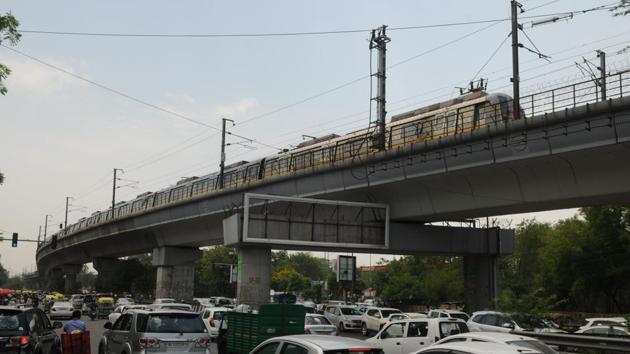Experts cautious and citizens upbeat over Metro expansion
Experts, on the other hand, cautioned that without adequate integration with the city’s bus service and proper road planning, the upcoming corridor can the risk of underperformance in the same manner as the Rapid Metro.
The Haryana government’s announcement of the Metro expansion in the city has drawn mixed responses from citizens and experts. Commuters, from both Delhi and Gurugram, who frequently travel to older parts of the city expressed relief at the development. Experts, on the other hand, cautioned that without adequate integration with the city’s bus service and proper road planning, the upcoming corridor can the risk of underperformance in the same manner as the Rapid Metro.

On Monday, during the fourth meeting of the Gurugram Metropolitan Development Authority (GMDA), chief minister Manohar Lal Khattar approved a detailed project report of a new Metro corridor, which will run from Huda City Centre to Cyber City (via Subash Chowk and Udyog Vihar), for a length of 31km, acting as an extension of the Delhi Metro Rail Corporation’s (DMRC) Yellow Line.
Commuters are hopeful. For Rajesh Joon, who travels daily from Sushant Lok to Udyog Vihar, the expanded corridor will act as a blessing. “It will save me the hassle of haggling with auto drivers, or paying for private cabs,” he said.
Experts agreed that commuters would benefit immensely from the proposed expansion plans. According to a recent survey by the School of Planning and Architecture(SPA) in New Delhi, the DMRC’s Yellow Line sees over 2,80,000 people enter Gurugram each day. “Many of these people use Huda City Centre as an interchange hub for switching between different modes of transport. For those wishing to continue on the extended route, the new Metro corridor will make travel seamless,” said a senior faculty member at the SPA, requesting anonymity.
Experts, however, raised concerns of whether the project would impact the lives of citizens who live and travel within Gurugram, where private vehicles dominate the city streets. Navdeep Asija, a transport consultant with the government of Punjab, said, “Gurugram is far more dependent on private vehicles than Delhi, and given the relatively short length of the proposed corridor, it might not make much of a dent in the number of private cars and two-wheelers on the roads.” This, experts explained, goes against the fundamental purpose of mass transit systems.
Studies show that people who opt to travel by mass transit systems usually do so for distances of about 15 kilometres or more. “This is why the Metro has been successful in Delhi. But the benefits of extending the Delhi line, for citizens making intra-city trips in Gurugram, is still a matter of concern,” Asija said. According to the aforementioned survey by the SPA, the average “trip length” for a private car in the city is just 9.8km, while the average trip length including other modes of transport (such as autos, two-wheelers and buses) is even lesser, at 7km.“This does not bode well for the Metro’s ridership prospects. Those who can afford cars will still prefer to use them,” said the senior faculty member at the SPA.
Experts also provided the example of Gurugram’s failing Rapid Metro service, which continues to struggle to accrue ridership and revenue. “One of the reasons why the Rapid Metro has failed is because it is built over a six-lane road that runs parallel to National Highway-48. The presence of this road discourages people from using the Rapid Metro,” explained Sarika Panda Bhatt, a city-based transportation consultant.
In Udyog Vihar, through which the expanded corridor is set to pass, road- widening projects are currently in the pipeline. “This will be counter-productive, as it will again give more incentive to private vehicles, which are logistically more convenient, instead of boosting ridership on the Metro,” Bhatt explained.
Several sections of the citizenry — mainly those living beyond Sector 58, near Sohna Road, and closer to the Dwarka Expressway — have said that the alignment would not benefit the larger population. Prakhar Sahay, president of the Dwarka Expressway RWA, said, “It would have been more viable in the long term to create a Metro line nearer to the Kherki Daula toll plaza that can then be connected to Dwarka in West Delhi, where the Metro lines are already being constructed.” Experts were in consonance with this opinion.
As Gurugram attempts to establish its own intra-city Metro service, multiple experts warned that it would need to learn from Delhi’s mistakes. Bhatt pointed out that 85% of Delhi’s population lives within a few kilometres of a Metro station, yet buses in the Capital are overcrowded due to issues of first- and last-mile connectivity. She said, “The Delhi Metro carries 25 lakh passengers each day, but there are 5,000 buses in the Capital carrying about 50 lakh passengers every day.” This is due to the poor integration of the Metro with the bus system, as well as high ticket prices.
Rohit Prasad, a professor of economics at MDI University, said, “The cost per kilometre of running this service corridor seems to be on the higher side. It might be beneficial to use alternative models, such as peak-load pricing, because of the type of riders the service will attract in Old Gurugram, which is an under-serviced part of the city, where people might not necessarily be able to afford the high price of a Metro ticket.”
A senior functionary in the GMDA’s transport division, said, “We will be closely integrating the bus and Metro services. By the time the Metro is active, the Gurugaman service will be able to meet this requirement.”



